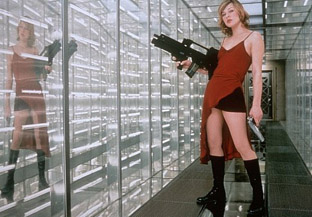What Went Right: Resident Evil Part I
By Shalimar Sahota
September 11, 2012
By the time the sequel Resident Evil: Apocalypse was released, the franchise hadn’t just picked up fans from the first film, but those that were discovering the games for the first time. An exclusive deal between Capcom and Nintendo saw the original Resident Evil game remade for Nintendo’s Gamecube console, with all new graphics, as well as additional gameplay and story elements. It was released in North America in April 2002, not long after the first film was released, and became a critical and financial success. Capcom later followed this up with the new prequel Resident Evil: Zero, which was released a few months later in November. Throughout 2003, Capcom re-released straight ports of Resident Evil 2, Resident Evil 3: Nemesis and Resident Evil: Code Veronica X on the Gamecube console, which brought a whole new generation of fans to the survival horror franchise.
Now, greenlighting a sequel to a critically mauled film isn’t always the best idea. If the first one wasn’t so well received, then what are the chances that even half the audience will return for a sequel? While worldwide takings made Resident Evil a hit, it also turned out to be very popular on DVD. For Resident Evil: Apocalypse Anderson stuck around as producer and writer, but went off to work on Alien vs. Predator, so directing duties went to Alexander Witt (his first and only directorial feature). With a larger production budget of $45 million, the action was no longer confined to an underground laboratory. The story has Umbrella reopen The Hive to find out what went on down there. Obviously a bad idea for T-virus escapes and ends up seeping through Raccoon City.
Interestingly Apocalypse is the only film in the series where the storyline adheres to that of the videogames, taking place during the timeline of the second and third Resident Evil games. A lot of elements have been carried over. Not just creatures and characters (the film introduces Jill Valentine, played by Sienna Guillory, and Carlos Olivera, played by Oded Fehr), but locations, dialogue and scenarios too. It isn’t simply about adding visual iconography, but trying to replicate the experience as well. For example, in the game Resident Evil 3: Nemesis, as players control Jill Valentine, they have to be quick to avoid or subdue the hugely overpowering Nemesis monster. In the film, Alice’s first encounter with the Nemesis highlights the pure terror that comes across when faced with the unstoppable monster. Also from the same game, the film includes the destruction of Raccoon City. The opening cut scene from Resident Evil: Code Veronica is incorporated too, where Claire Redfield avoids machinegun fire from a helicopter. That this action is performed in the film by Alice helps establish her as a more prominent character.
One of the producers on Apocalypse, Don Carmody, wanted to change the look of the Nemesis for the film, feeling that it could have been improved upon. “It drove me insane that the Nemesis had to look like that,” said Carmody. “I could have made it a much scarier monster but [the game designers] insisted he look like that.” Knowing that it would attract fans of the games, they didn’t screw around with the look of the Nemesis. Fans may regard the film as a more authentic adaptation because of how closely the characters resemble their videogame counterparts.
During the commentary on Apocalypse, Anderson explained some of the hurdles when it comes to adapting a videogame, saying, “People that run the studios are just older, they don’t get it. They don’t understand fast cutting and they don’t understand the rapid movements and they have problems with the narrative. Sometimes we’ve definitely fought in our movies not to try and over-explain things too much. Because there’s often a studio push to, ‘I have to understand this, I have to understand that’, and we’re like, ‘No, you know what, the audience this is aimed at, they get it. Unfortunately they’re just a bit faster and a bit cleverer than you are.’”
Resident Evil: Apocalypse opened in September 2004 (since Apocalypse each Resident Evil film has opened in September). It was critically derided. On review aggregator site Rotten Tomatoes, out of all the films it has the lowest score, with a 21% fresh rating from critics. That didn’t stop the film grossing $23 million on its opening weekend. Dropping quickly, it finished its domestic run with $51.2 million. Add in international takings and the film had managed a worldwide total of $129.3 million. Resident Evil was now a successful film franchise.
Continued:
1
2
3
|
|
|
|




